Linksys WRT54GL User Manual
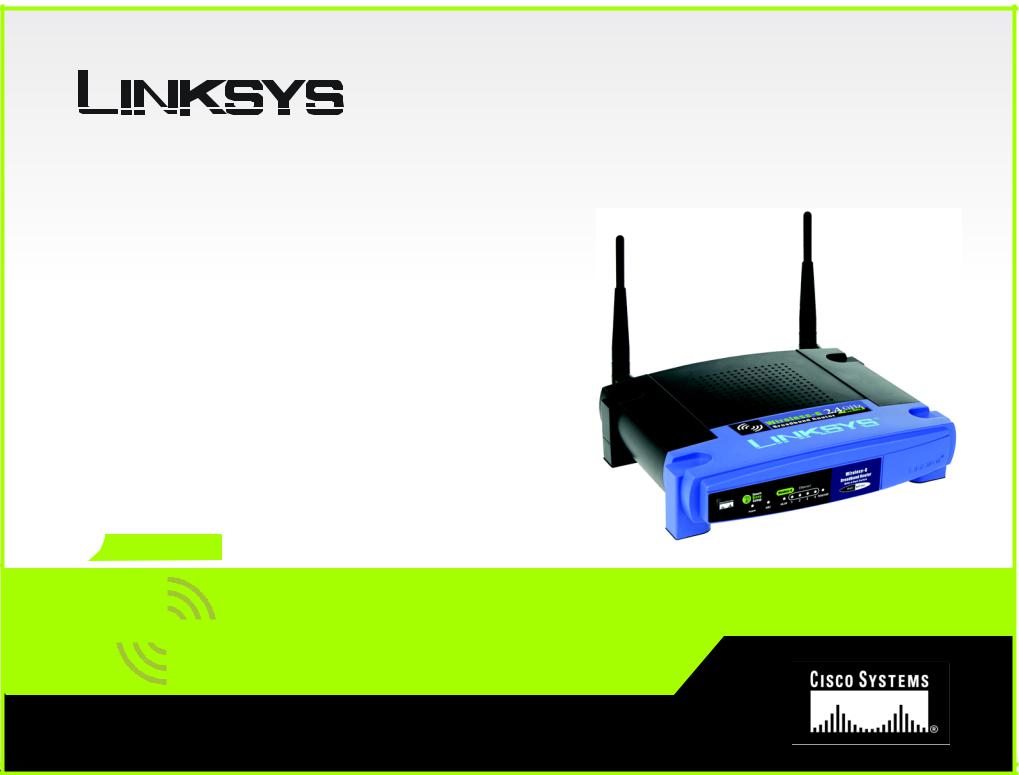
® |
|
A Division of Cisco Systems, Inc. |
|
2.4802GHz.11g Wireless-G |
User Guide |
Broadband Router |
|
WIRELESS |
|
Model No. WRT54GL |
|

Wireless-G Broadband Router
Copyright and Trademarks
Specifications are subject to change without notice. Linksys is a registered trademark or trademark of Cisco Systems, Inc. and/or its affiliates in the U.S. and certain other countries. Copyright © 2005 Cisco Systems, Inc. All rights reserved. Other brands and product names are trademarks or registered trademarks of their respective holders.
WARNING: This product contains chemicals, including lead, known to the State of California to cause cancer, and birth defects or other reproductive harm. Wash hands after handling.
How to Use This User Guide
This User Guide has been designed to make understanding networking with the Wireless-G Broadband Router easier than ever. Look for the following items when reading this User Guide:
This checkmark means there is a note of interest and is something you should pay special attention to while using the Wireless-G Broadband Router.
This exclamation point means there is a caution or warning and is something that could damage your property or the Wireless-G Broadband Router.
This question mark provides you with a reminder about something you might need to do while using the Wireless-G Broadband Router.
In addition to these symbols, there are definitions for technical terms that are presented like this:
word: definition.
Also, each figure (diagram, screenshot, or other image) is provided with a figure number and description, like this:
Figure 0-1: Sample Figure Description
Figure numbers and descriptions can also be found in the “List of Figures” section in the “Table of Contents”.
WRT54GL-UG-50921 KL
Wireless-G Broadband Router
Table of Contents
Chapter 1: Introduction |
1 |
Welcome |
1 |
What’s in this User Guide? |
2 |
Chapter 2: Planning Your Wireless Network |
4 |
Network Topology |
4 |
Ad-Hoc versus Infrastructure Mode |
4 |
Network Layout |
4 |
Chapter 3: Getting to Know the Wireless-G Broadband Router |
6 |
The Back Panel |
6 |
The Front Panel |
7 |
Chapter 4: Connecting the Wireless-G Broadband Router |
8 |
Overview |
8 |
Hardware Installation for Connection to Your Broadband Modem |
8 |
Hardware Installation for Connection to Another Router |
10 |
Chapter 5: Setting up the Wireless-G Broadband Router |
12 |
Overview |
12 |
Using the Setup Wizard |
12 |
Using SecureEasySetup to Configure Your Notebook |
29 |
Chapter 6: Configuring the Wireless-G Broadband Router |
32 |
Overview |
32 |
The Setup Tab - Basic Setup |
33 |
The Setup Tab - DDNS |
37 |
The Setup Tab - MAC Address Clone |
38 |
The Setup Tab - Advanced Routing |
39 |
The Wireless Tab - Basic Wireless Settings |
40 |
The Wireless Tab - Wireless Security |
41 |
The Wireless Tab - Wireless MAC Filter |
44 |
The Wireless Tab - Advanced Wireless Settings |
45 |
The Security Tab - Firewall |
47 |
The Security Tab - VPN Passthrough |
47 |
The Access Restrictions Tab - Internet Access |
48 |
The Applications and Gaming Tab - Port Range Forward |
50 |
Wireless-G Broadband Router |
|
The Applications & Gaming Tab - Port Triggering |
51 |
The Applications and Gaming Tab - DMZ |
52 |
The Applications and Gaming Tab - QoS |
52 |
The Administration Tab - Management |
54 |
The Administration Tab - Log |
54 |
The Administration Tab - Diagnostics |
55 |
The Administration Tab - Factory Defaults |
56 |
The Administration Tab - Firmware Upgrade |
56 |
The Administration Tab - Config Management |
56 |
The Status Tab - Router |
57 |
The Status Tab - Local Network |
58 |
The Status Tab - Wireless |
59 |
Appendix A: Troubleshooting |
60 |
Common Problems and Solutions |
60 |
Frequently Asked Questions |
68 |
Appendix B: Wireless Security |
75 |
Security Precautions |
75 |
Security Threats Facing Wireless Networks |
75 |
Appendix C: Upgrading Firmware |
78 |
Appendix D: Windows Help |
79 |
Appendix E: Finding the MAC Address and IP Address for Your Ethernet Adapter |
80 |
Windows 98SE or Me Instructions |
80 |
Windows 2000 or XP Instructions |
80 |
For the Router’s Web-based Utility |
81 |
Appendix F: Glossary |
82 |
Appendix G: Specifications |
89 |
Appendix H: Warranty Information |
91 |
Appendix I: Regulatory Information |
92 |
Appendix J: Contact Information |
94 |
Wireless-G Broadband Router
List of Figures
Figure 3-1: The Router’s Back Panel |
6 |
Figure 3-2: The Router’s Front Panel |
7 |
Figure 4-1: Connecting Your Internet Connection |
8 |
Figure 4-2: Connecting Your Network Devices |
9 |
Figure 4-3: Connecting the Power |
9 |
Figure 4-4: Diagram for Connection to Another Router |
10 |
Figure 4-5: Connecting Another Router |
10 |
Figure 4-6: Connecting Your Network Devices |
11 |
Figure 4-7: Connecting the Power |
11 |
Figure 5-1: Setup Wizard’s Welcome - Language Selection Screen |
12 |
Figure 5-2: Setup Wizard’s Welcome - Start Wizard Screen |
12 |
Figure 5-3: Setup Wizard’s License Agreement Screen |
13 |
Figure 5-4: Setup Wizard’s Disconnect the Modem from the PC Screen |
13 |
Figure 5-5: Setup Wizard’s Connect the Modem to the Router Screen |
14 |
Figure 5-6: Setup Wizard’s Connect a Network Cable to a PC Screen |
14 |
Figure 5-7: Setup Wizard’s Connect the Network Cable to the Router Screen |
15 |
Figure 5-8: Setup Wizard’s Power on the Router Screen |
15 |
Figure 5-9: Setup Wizard’s Check the Router’s Status Screen |
16 |
Figure 5-10: Setup Wizard’s Configure Cable or DHCP Settings Screen |
16 |
Figure 5-11: Setup Wizard’s Configure DSL (PPPoE) Settings Screen |
17 |
Figure 5-12: Setup Wizard’s Advanced Internet Settings - Static IP Screen |
17 |
Figure 5-13: Setup Wizard’s Advanced Internet Settings - PPTP Screen |
18 |
Figure 5-14: Setup Wizard’s Keep Alive/Connect on Demand (PPTP Continued) Screen |
18 |
Figure 5-15: Setup Wizard’s Advanced Internet Settings - L2TP Screen |
19 |
Figure 5-16: Setup Wizard’s Advanced Internet Settings - Telstra Screen |
20 |
Figure 5-17: Setup Wizard’s Set the Router’s Password Screen |
21 |
Figure 5-18: Setup Wizard’s Configure Wireless Settings Screen |
21 |
Figure 5-19: Setup Wizard’s SecureEasySetup Screen |
22 |
Figure 5-20: SecureEasySetup Logo |
22 |
Figure 5-21: Additional Information - Hardware Button |
22 |
Figure 5-22: Additional Information - Software Button |
22 |
Wireless-G Broadband Router |
|
Figure 5-23: Setup Wizard’s Configure Wireless Settings Screen |
23 |
Figure 5-24: Setup Wizard’s Confirm New Settings Screen |
23 |
Figure 5-25: Setup Wizard’s Safe Surfing Screen |
24 |
Figure 5-26: Setup Wizard’s Congratulations Screen |
24 |
Figure 5-27: Setup Wizard’s Configure Wireless Settings Screen |
25 |
Figure 5-28: Setup Wizard’s Wireless Settings Screen |
25 |
Figure 5-29: Setup Wizard’s Wireless Security - WPA-PSK Screen |
26 |
Figure 5-30: Setup Wizard’s Wireless Security - WEP (64-Bit) Screen |
27 |
Figure 5-32: Setup Wizard’s Confirm New Settings Screen |
27 |
Figure 5-31: Setup Wizard’s Norton Screen |
28 |
Figure 5-33: Setup Wizard’s Congratulations Screen |
28 |
Figure 5-34: Setup Wizard’s Welcome - Start Wizard Screen |
29 |
Figure 5-35: SecureEasySetup Welcome Screen |
29 |
Figure 5-36: Configure Wireless Settings #1 Screen |
30 |
Figure 5-37: Configure Wireless Settings #2 Screen |
30 |
Figure 5-38: Your Wireless Settings Screen |
31 |
Figure 6-1: Password Screen |
32 |
Figure 6-2: Setup Tab - Basic Setup |
33 |
Figure 6-3: DHCP Connection Type |
33 |
Figure 6-4: Static IP Connection Type |
33 |
Figure 6-5: PPPoE Connection Type |
34 |
Figure 6-6: PPTP Connection Type |
34 |
Figure 6-7: HeartBeat Signal Connection Type |
35 |
Figure 6-8: Optional Settings |
35 |
Figure 6-9: Router IP |
36 |
Figure 6-10: Network Address Server Settings |
36 |
Figure 6-11: Time Setting |
36 |
Figure 6-12: Setup Tab - DDNS |
37 |
Figure 6-13: Setup Tab - MAC Address Clone |
38 |
Figure 6-14: Setup Tab - Advanced Routing (Gateway) |
39 |
Figure 6-15: Setup Tab - Advanced Routing (Router) |
39 |
Figure 6-16: Wireless Tab - Basic Wireless Settings |
40 |
Figure 6-17: Wireless Tab - Wireless Security (WPA Personal) |
41 |
Figure 6-18: Wireless Tab - Wireless Security (WPA Enterprise) |
41 |
Wireless-G Broadband Router |
|
Figure 6-19: Wireless Tab - Wireless Security (WPA2 Personal) |
42 |
Figure 6-20: Wireless Tab - Wireless Security (WPA2 Enterprise) |
42 |
Figure 6-21: Wireless Tab - Wireless Security (RADIUS) |
43 |
Figure 6-22: Wireless Tab - Wireless Security (WEP) |
43 |
Figure 6-23: Wireless Tab - Wireless MAC Filter |
44 |
Figure 6-24: MAC Address Filter List |
44 |
Figure 6-25: Wireless Tab - Advanced Wireless Settings |
45 |
Figure 6-26: Security Tab - Firewall |
47 |
Figure 6-27: Security Tab - VPN Passthrough |
47 |
Figure 6-28: Access Restrictions Tab - Internet Access |
48 |
Figure 6-29: Internet Policy Summary |
48 |
Figure 6-30: List of PCs |
48 |
Figure 6-31: Port Services |
49 |
Figure 6-32: Access Restrictions Tab - Inbound Traffic |
49 |
Figure 6-33: Applications and Gaming Tab - Port Range Forward |
50 |
Figure 6-34: Applications and Gaming Tab - Port Triggering |
51 |
Figure 6-35: Applications and Gaming Tab - DMZ |
52 |
Figure 6-36: Applications and Gaming Tab - QOS |
52 |
Figure 6-37: Administration Tab - Management |
54 |
Figure 6-38: Administration Tab - Log |
54 |
Figure 6-39: Administration Tab - Diagnostics |
55 |
Figure 6-40: The Ping Test |
55 |
Figure 6-41: The Traceroute Test |
55 |
Figure 6-42: Administration Tab - Factory Defaults |
56 |
Figure 6-43: Administration Tab - Firmware Upgrade |
56 |
Figure 6-44: Administration Tab - Config Management |
56 |
Figure 6-45: Status Tab - Router |
57 |
Figure 6-46: Status Tab - Local Network |
58 |
Figure 6-47: DHCP Clients Table |
58 |
Figure 6-48: Status Tab - Wireless |
59 |
Figure C-1: Upgrade Firmware |
78 |
Figure E-1: IP Configuration Screen |
80 |
Figure E-2: MAC Address/Adapter Address |
80 |
Figure E-3: MAC Address/Physical Address |
80 |
Figure E-4: MAC Address Filter List |
81 |
Wireless-G Broadband Router
Figure E-5: MAC Address Clone |
81 |
Wireless-G Broadband Router
Chapter 1: Introduction
Welcome
Thank you for choosing the Linksys Wireless-G Broadband Router. The Wireless-G Broadband Router will allow you to network wirelessly better than ever, sharing Internet access, files and fun, easily and securely.
How does the Wireless-G Broadband Router do all of this? A router is a device that allows access to an Internet connection over a network. With the Wireless-G Broadband Router, this access can be shared over the four switched ports or via the wireless broadcast at up to 11Mbps for Wireless-B or up to 54Mbps for Wireless-G.
Use the WPA standard to secure your wireless network while the whole network is protected through a Stateful Packet Inspection (SPI) firewall and Network Address Translation (NAT) technology. The Router’s SecureEasySetup™ feature makes it a snap to set up WPA when you have other SecureEasySetup devices— notebooks, printers, other peripherals—comprising your network. Run the Setup Wizard and it will guide you through the steps. You can also access the Router’s features through the easy-to-use, browser-based utility.
But what does all of this mean?
Networks are useful tools for sharing computer resources. You can access one printer from different computers and access data located on another computer's hard drive. Networks are even used for playing multiplayer video games. So, networks are not only useful in homes and offices, they can also be fun.
PCs on a wired network create a LAN, or Local Area Network. They are connected with Ethernet cables, which is why the network is called “wired”.
PCs equipped with wireless cards or adapters can communicate without cumbersome cables. By sharing the same wireless settings, within their transmission radius, they form a wireless network. This is sometimes called a WLAN, or Wireless Local Area Network. The Wireless-G Broadband Router bridges wireless networks of both 802.11b and 802.11g standards and wired networks, allowing them to communicate with each other.
With your networks all connected, wired, wireless, and the Internet, you can now share files and Internet access—and even play games. All the while, the Wireless-G Broadband Router protects your networks from unauthorized and unwelcome users.
Linksys recommends using the Setup CD-ROM for first-time installation of the Router. If you do not wish to run the Setup Wizard on the Setup CD-ROM, then use the instructions in this Guide to help you connect the Wireless-G Broadband Router, set it up, and configure it to bridge your different networks. These instructions should be all you need to get the most out of the Wireless-G Broadband Router.
Chapter 1: Introduction
wpa (wi-fi protected access): a wireless security protocol using TKIP (Temporal Key Integrity Protocol) encryption, which can be used in conjunction with a RADIUS server.
spi (stateful packet inspection) firewall: a technology that inspects incoming packets of information before allowing them to enter the network.
firewall: Security measures that protect the resources of a local network from intruders.
nat (network address translation): NAT technology translates IP addresses of a local area network to a different IP address for the Internet.
lan (local area network): The computers and networking products that make up the network in your home or office.
1
Welcome
Wireless-G Broadband Router
What’s in this User Guide?
This user guide covers the steps for setting up and using the Wireless-G Broadband Router.
•Chapter 1: Introduction
This chapter describes the Router’s applications and this User Guide.
•Chapter 2: Planning Your Wireless Network
This chapter describes the basics of wireless networking.
•Chapter 3: Getting to Know the Wireless-G Broadband Router This chapter describes the physical features of the Router.
•Chapter 4: Connecting the Wireless-G Broadband Router
This chapter instructs you on how to connect the Router to your network.
•Chapter 5: Setting up the Wireless-G Broadband Router
This chapter walks you through the steps of the Wireless-G Broadband Router’s Setup Wizard to configure its settings. It also covers the instructions for using the Router’s SecureEasySetup feature to create your wireless network.
•Chapter 6: Configuring the Wireless-G Broadband Router
This chapter explains how to use the Web-based Utility to configure the settings on the Wireless-G Broadband Router.
•Appendix A: Troubleshooting
This appendix describes some problems and solutions, as well as frequently asked questions, regarding installation and use of the Wireless-G Broadband Router.
•Appendix B: Wireless Security
This appendix explains the risks of wireless networking and some solutions to reduce the risks.
•Appendix C: Upgrading Firmware
This appendix instructs you on how to upgrade the firmware on the Router should you need to do so.
•Appendix D: Windows Help
This appendix describes how you can use Windows Help for instructions about networking, such as installing the TCP/IP protocol.
Chapter 1: Introduction |
2 |
What’s in this User Guide?
Wireless-G Broadband Router
•Appendix E: Finding the MAC Address and IP Address for your Ethernet Adapter.
This appendix describes how to find the MAC address for your computer’s Ethernet adapter so you can use the MAC filtering and/or MAC address cloning feature of the Router.
•Appendix F: Glossary
This appendix gives a brief glossary of terms frequently used in networking.
•Appendix G: Specifications
This appendix provides the technical specifications for the Router.
•Appendix H: Warranty Information
This appendix supplies the warranty information for the Router.
•Appendix I: Regulatory Information
This appendix supplies the regulatory information regarding the Router.
•Appendix J: Contact Information
This appendix provides contact information for a variety of Linksys resources, including Technical Support.
Chapter 1: Introduction |
3 |
What’s in this User Guide?
Wireless-G Broadband Router
Chapter 2: Planning Your Wireless Network
Network Topology
A wireless local area network (WLAN) is exactly like a regular local area network (LAN), except that each computer in the WLAN uses a wireless device to connect to the network. Computers in a WLAN share the same frequency channel and SSID, which is an identification name shared by the wireless devices belonging to the same wireless network.
ssid (service set identifier): your wireless network’s name.
Ad-Hoc versus Infrastructure Mode
Unlike wired networks, wireless networks have two different modes in which they may be set up: infrastructure and ad-hoc. An infrastructure configuration is a WLAN and wired LAN communicating to each other through an access point. An ad-hoc configuration is wireless-equipped computers communicating directly with each other. Choosing between these two modes depends on whether or not the wireless network needs to share data or peripherals with a wired network or not.
If the computers on the wireless network need to be accessible by a wired network or need to share a peripheral, such as a printer, with the wired network computers, the wireless network should be set up in Infrastructure mode. The basis of Infrastructure mode centers around a wireless router or an access point, such as the Wireless-G Broadband Router, which serves as the main point of communications in a wireless network. The Router transmits data to PCs equipped with wireless network adapters, which can roam within a certain radial range of the Router. You can arrange the Router and multiple access points to work in succession to extend the roaming range, and you can set up your wireless network to communicate with your Ethernet hardware as well.
If the wireless network is relatively small and needs to share resources only with the other computers on the wireless network, then the Ad-Hoc mode can be used. Ad-Hoc mode allows computers equipped with wireless transmitters and receivers to communicate directly with each other, eliminating the need for a wireless router or access point. The drawback of this mode is that in Ad-Hoc mode, wireless-equipped computers are not able to communicate with computers on a wired network. And, of course, communication between the wirelessequipped computers is limited by the distance and interference directly between them.
Network Layout
The Wireless-G Broadband Router has been specifically designed for use with both your 802.11b and 802.11g products. Now, products using these standards can communicate with each other.
infrastructure: a wireless network that is bridged to a wired network via an access point.
ad-hoc: a group of wireless devices communicating directly to each other (peer-to- peer) without the use of an access point.
Chapter 2: Planning Your Wireless Network |
4 |
Network Topology
Wireless-G Broadband Router
The Wireless-G Broadband Router is compatible with all 802.11b and 802.11g adapters, such as the Notebook Adapters (WPC54G, WPC11) for your laptop computers, PCI Adapter (WMP54G, WMP11) for your desktop PC, and USB Adapter (WUSB54G, WUSB11) when you want to enjoy USB connectivity. The Broadband Router will also communicate with the Wireless PrintServer (WPS54G) and Wireless Ethernet Bridges (WET54G, WET11).
When you wish to connect your wireless network with your wired network, you can use the Wireless-G Broadband Router’s four LAN ports. To add more ports, any of the Wireless-G Broadband Router's LAN ports can be connected to any of Linksys's switches (such as the SD205 or SD208).
With these, and many other, Linksys products, your networking options are limitless. Go to the Linksys website at
www.linksys.com for more information about products that work with the Wireless-G Broadband Router.
Chapter 2: Planning Your Wireless Network |
5 |
Network Layout

Wireless-G Broadband Router
Chapter 3: Getting to Know the Wireless-G Broadband Router
The Back Panel
The Router's ports, where the cables are connected, are located on the back panel.
|
Figure 3-1: The Router’s Back Panel |
Reset Button |
There are two ways to reset the Router's factory defaults. Either press the Reset Button, for |
|
approximately five seconds, or restore the defaults from the Administration tab - Factory |
|
Defaults in the Router's Web-based Utility. |
Internet |
The Internet port is where you will connect your broadband Internet connection. |
1, 2, 3, 4 |
These ports (1, 2, 3, 4) connect the Router to your networked PCs and other Ethernet network |
|
devices. |
IMPORTANT: Resetting the Router will erase all of your settings (Internet connection, wireless security, and other settings) and replace them with the factory defaults. Do not reset the Router if you want to retain these settings.
Power |
The Power port is where you will connect the power adapter. |
Chapter 3: Getting to Know the Wireless-G Broadband Router |
6 |
The Back Panel
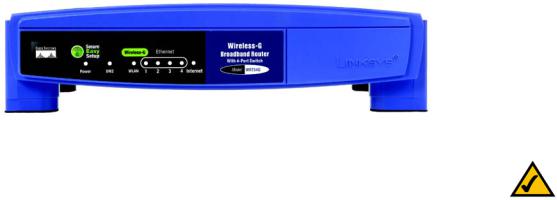
Wireless-G Broadband Router
The Front Panel
The Router’s SecureEasySetup button (the Cisco logo) and LEDs are located on the front panel.
|
Figure 3-2: The Router’s Front Panel |
(Cisco logo) |
Orange/White. The Cisco logo is the Router’s SecureEasySetup button. It lights up and will stay |
|
orange when the Router is powered on. The color orange indicates that the Router is not using |
|
the SecureEasySetup feature, while the color white indicates that the Router is using the |
|
SecureEasySetup feature. When the Router enters SecureEasySetup mode, the Cisco logo will |
|
turn white and start flashing. After the Router has generated the SSID and WPA-PSK (also |
|
called WPA-Personal) key, the Cisco logo will stop flashing and stay white. |
|
To clear the SSID and WPA-PSK key, press and hold down the Cisco logo for five seconds. The |
|
Cisco logo will flash slowly as the Router resets itself. The Cisco logo will turn orange to |
|
indicate a successful reset. |
Power |
Green. The Power LED lights up and will stay on while the Router is powered on. When the |
|
Router goes through its self-diagnostic mode during every boot-up, this LED will flash. When |
|
the diagnostic is complete, the LED will be solidly lit. |
DMZ |
Green. The DMZ LED indicates when the DMZ function is being used. This LED will remain lit |
|
as long as DMZ is enabled. |
WLAN |
Green. The WLAN LED lights up whenever there is a successful wireless connection. If the LED |
|
is flashing, the Router is actively sending or receiving data over the network. |
1, 2, 3, 4 |
Green. These numbered LEDs, corresponding with the numbered ports on the Router’s back |
|
panel, serve two purposes. If the LED is continuously lit, the Router is successfully connected |
|
to a device through that port. A flashing LED indicates network activity over that port. |
Internet |
Green. The Internet LED lights up when there is a connection made through the Internet port. |
Chapter 3: Getting to Know the Wireless-G Broadband Router
NOTE: SecureEasySetup is a feature that makes it easy to set up your wireless network. If you have SecureEasySetup devices, run the Router’s Setup Wizard CD-ROM and follow the on-screen instructions to use SecureEasySetup.
7
The Front Panel
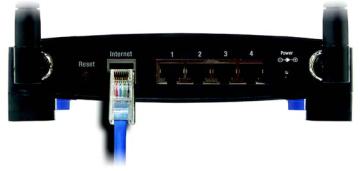
Wireless-G Broadband Router
Chapter 4: Connecting the Wireless-G Broadband Router
Overview
This chapter includes two sets of instructions. If the Wireless-G Broadband Router will be the only router in your network, follow the instructions in “Hardware Installation for Connection to Your Broadband Modem.” If you want to install the Wireless-G Broadband Router behind another router in your network, then follow the instructions in “Hardware Installation for Connection to Another Router.”
Hardware Installation for Connection to Your Broadband Modem
1.Power down your network devices.
2.Locate an optimum location for the Router. The best place for the Router is usually at the center of your wireless network, with line of sight to all of your mobile stations.
3.Fix the direction of the antennas. Try to place the Router in a position that will best cover your wireless network. Normally, the higher you place the antenna, the better the performance will be.
4.Connect a standard Ethernet network cable to the Router’s Internet port. Then, connect the other end of the Ethernet cable to your cable or DSL broadband modem.
Figure 4-1: Connecting Your Internet Connection
Chapter 4: Connecting the Wireless-G Broadband Router |
8 |
Overview
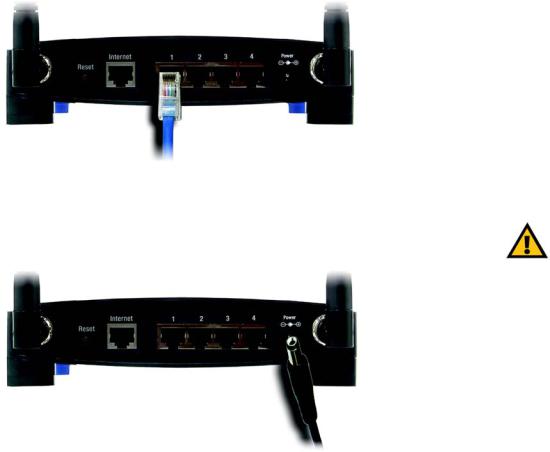
Wireless-G Broadband Router
5.Connect your network PCs or Ethernet devices to the Router’s numbered ports using standard Ethernet network cabling.
Figure 4-2: Connecting Your Network Devices
6.Connect the AC power adapter to the Router's Power port and the other end into an electrical outlet. Only use the power adapter supplied with the Router. Use of a different adapter may result in product damage.
Figure 4-3: Connecting the Power
Now that the hardware installation is complete, proceed to “Chapter 5: Setting up the Wireless-G Broadband Router,” for directions on how to configure the Router.
IMPORTANT: Make sure you use the power adapter that is supplied with the Router. Use of a different power adapter could damage the Router.
Chapter 4: Connecting the Wireless-G Broadband Router |
9 |
Hardware Installation for Connection to Your Broadband Modem
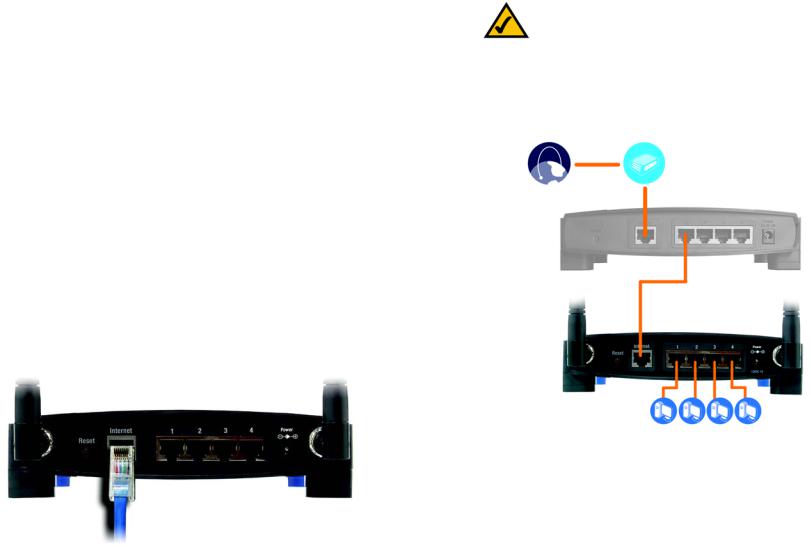
Wireless-G Broadband Router
Hardware Installation for Connection to Another Router
Before you install the Router, you must change the default IP address of the other router. This is mandatory because both routers may be set to the same IP address by default. If you do not change the other router’s default IP address, then you may not be able to set up the Router.
First, make sure the Router is NOT connected to your network. Then follow these instructions:
1.To access the other router’s Web-based Utility, launch Internet Explorer or Netscape Navigator, and enter the other router’s default IP address, 192.168.1.1, in the Address field. Then press Enter.
2.A password request page will appear. Leave the User Name field blank. In the Password field, enter the password you have set (the default password is admin). Then click the OK button.
3.The first screen that appears will display the Setup tab. In the Network Setup section, there is a setting called Local IP Address, which is set to 192.168.1.1. Change this to 192.168.2.1.
4.Click the Save Settings button to save your change, and then exit the Web-based Utility.
5.Power down your network devices. Now you will begin the hardware installation of Router.
6.Locate an optimum location for the Router. The best place for the Router is usually at the center of your wireless network, with line of sight to all of your mobile stations.
7.Fix the direction of the antennas. Try to place the Router in a position that will best cover your wireless network. Normally, the higher you place the antenna, the better the performance will be.
8.Connect a standard Ethernet network cable to the Router’s Internet port. Then, connect the other end of the Ethernet cable to one of the numbered Ethernet ports on your other router.
Figure 4-5: Connecting Another Router
Chapter 4: Connecting the Wireless-G Broadband Router
NOTE: Steps 1-4 are instructions for a typical Linksys router; however, if you are using a nonLinksys router, refer to the other router’s documentation for instructions on how to change its local IP address to 192.168.2.1.
Broadband
Internet Modem
Router
Wireless-G
Broadband
Router
Multiple PCs
Figure 4-4: Diagram for Connection to Another Router
10
Hardware Installation for Connection to Another Router
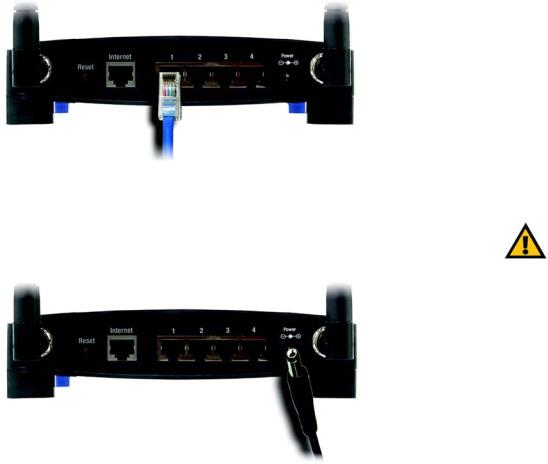
Wireless-G Broadband Router
9.Decide which network computers or Ethernet devices you want to connect to the Router.
Disconnect the selected computers or devices from the other router, and then connect them to the Router’s numbered ports using standard Ethernet network cabling.
Figure 4-6: Connecting Your Network Devices
10.Connect the AC power adapter to the Router's Power port and the other end into an electrical outlet. Only use the power adapter supplied with the Router. Use of a different adapter may result in product damage.
Figure 4-7: Connecting the Power
Now that the hardware installation is complete, proceed to “Chapter 5: Setting up the Wireless-G Broadband Router,” for directions on how to configure the Router.
Chapter 4: Connecting the Wireless-G Broadband Router
IMPORTANT: Make sure you use the power adapter that is supplied with the Router. Use of a different power adapter could damage the Router.
11
Hardware Installation for Connection to Another Router
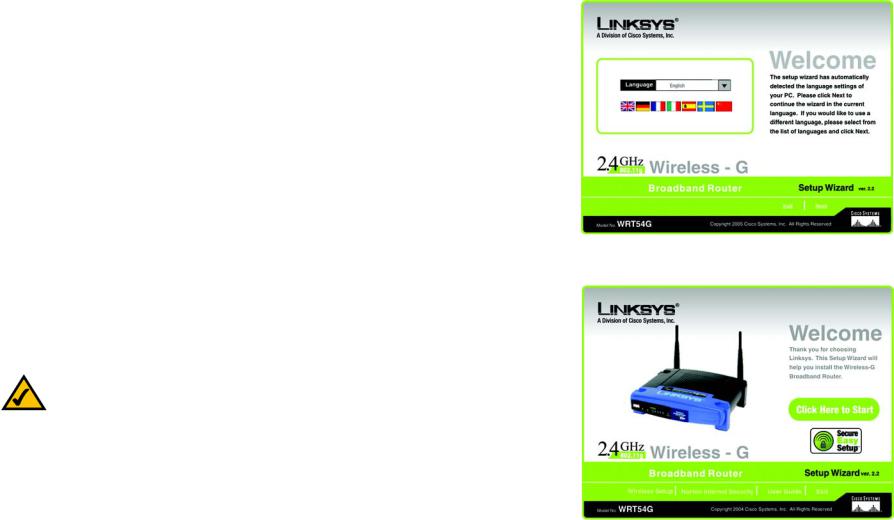
Wireless-G Broadband Router
Chapter 5: Setting up the Wireless-G Broadband Router
Overview
The Wireless-G Broadband Router Setup Wizard will guide you through the installation procedure. It will go through the instructions for configuring the Router’s network and wireless settings.
Using the Setup Wizard
1.Insert the Setup Wizard CD-ROM into your CD-ROM drive. The Setup Wizard should run automatically, and the Welcome screen should appear. If it does not, click the Start button and choose Run. In the field that appears, enter D:\setup.exe (if “D” is the letter of your CD-ROM drive).
2.The Setup Wizard will automatically detect the language setting of your PC. On the initial Welcome screen, click the Next button if you want to proceed with the Setup Wizard using the current language. If you want to use a different language, select the appropriate language, and then click the Next button.
3.On the following Welcome screen, click the Click Here to Start button if this is the first time you are running the Setup Wizard. These are your other choices:
Wireless Setup - If you have a computer displaying the SecureEasySetup logo, then click Wireless Setup and proceed to the section at the end of this chapter, “Using SecureEasySetup to Configure Your Notebook.”
NOTE: SecureEasySetup uses WPA-Personal encryption. If your current wireless devices do not support WPA-Personal security, then you cannot use SecureEasySetup on your network. You will need to manually configure your network security using the encryption supported by your existing devices.
Norton Internet Security - Click the Norton Internet Security button to install the Norton Internet Security software program.
User Guide - Click the User Guide button to open the PDF file of this User Guide.
Exit - Click the Exit button to exit the Setup Wizard.
Chapter 5: Setting up the Wireless-G Broadband Router
Figure 5-1: Setup Wizard’s Welcome - Language
Selection Screen
Figure 5-2: Setup Wizard’s Welcome - Start
Wizard Screen
12
Overview
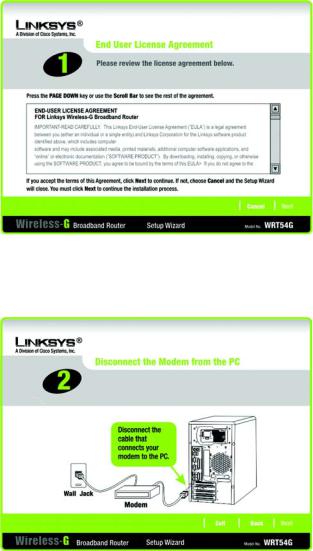
Wireless-G Broadband Router
4.After reading the License Agreement, click the Next button if you accept, or click the Cancel button to end the installation.
Figure 5-3: Setup Wizard’s License Agreement Screen
5.The Setup Wizard will ask you to disconnect your broadband modem from your PC. After you have done so, click the Next button.
Figure 5-4: Setup Wizard’s Disconnect the Modem from the PC Screen
Chapter 5: Setting up the Wireless-G Broadband Router |
13 |
Using the Setup Wizard
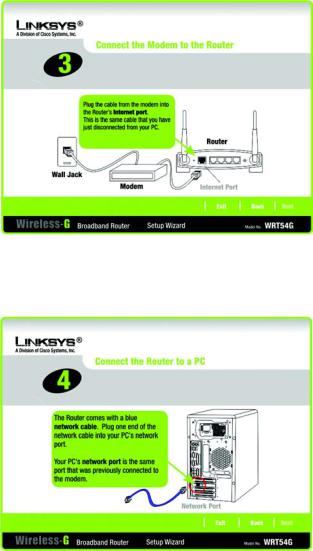
Wireless-G Broadband Router
6.The Setup Wizard will ask you to connect your broadband modem to the Router. After you have done so, click the Next button.
Figure 5-5: Setup Wizard’s Connect the Modem to the
Router Screen
7.The Setup Wizard will ask you to connect a network cable to your PC. After you have done so, click the Next button.
Figure 5-6: Setup Wizard’s Connect a Network Cable to a
PC Screen
Chapter 5: Setting up the Wireless-G Broadband Router |
14 |
Using the Setup Wizard
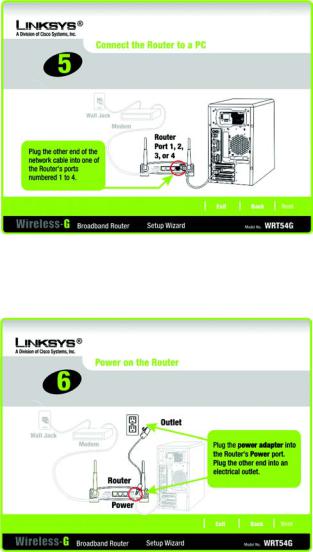
Wireless-G Broadband Router
8.The Setup Wizard will ask you to connect the other end of the network cable to the Router. Then you can also connect additional PCs to the Router.
After you have done so, click the Next button.
9. The Setup Wizard will ask you to power on the Router. After you have done so, click the Next button.
Figure 5-7: Setup Wizard’s Connect the Network Cable to the Router Screen
Figure 5-8: Setup Wizard’s Power on the Router Screen
Chapter 5: Setting up the Wireless-G Broadband Router |
15 |
Using the Setup Wizard

Wireless-G Broadband Router
10.Make sure the Router’s Power, Internet, and numbered LEDs (depending on the number of PCs connected) are lit on its front panel. After you have done so, click the Next button.
Figure 5-9: Setup Wizard’s Check the Router’s
Status Screen
11.The Setup Wizard will automatically detect the Internet connection type you use: Cable or DHCP or DSL (PPPoE). If the Setup Wizard cannot detect your Internet connection type, you will see the Advanced Internet Settings screen, and you will be asked to select your Internet connection type: Static IP, PPTP, L2TP, or Telstra. Proceed to the appropriate section for your Internet connection type.
Cable or DHCP
Host Name - Enter the Host Name if required by your ISP; otherwise, leave this field blank.
Domain Name - Enter the Domain Name if required by your ISP; otherwise, leave this field blank.
Click the Next button to continue or the Back button to return to the previous screen.
Figure 5-10: Setup Wizard’s Configure Cable or DHCP
Settings Screen
Chapter 5: Setting up the Wireless-G Broadband Router |
16 |
Using the Setup Wizard
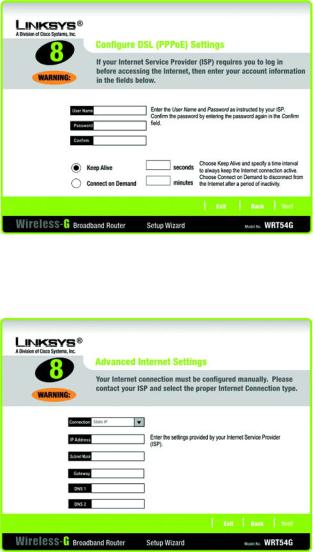
Wireless-G Broadband Router
DSL (PPPoE)
User Name - Enter the User Name provided by your ISP.
Password - Enter the Password provided by your ISP.
Confirm - To confirm the Password, enter it again in this field.
Keep Alive - If you want the Router to periodically check your Internet connection, select Keep Alive. Then specify how often you want the Router to check the Internet connection. If the connection is down, the Router will automatically re-establish your connection.
Connect on Demand - If you want the Router to end the Internet connection after it has been inactive for a period of time, select Connect on Demand and designate the number of minutes you want that period of inactivity to last.
Click the Next button to continue or the Back button to return to the previous screen.
Figure 5-11: Setup Wizard’s Configure DSL (PPPoE)
Settings Screen
Static IP
Connection - If you are required to use a permanent IP address to connect to the Internet, select Static IP from the drop-down menu.
IP Address - Enter the IP address provided by your ISP.
Subnet MaskEnter the Subnet Mask provided by your ISP.
Gateway - Enter the Gateway IP address provided by your ISP.
DNS 1-2 - Enter the DNS (Domain Name System) server IP address(es) provided by your ISP. You need to enter at least one DNS address.
Click the Next button to continue or the Back button to return to the previous screen.
Figure 5-12: Setup Wizard’s Advanced Internet
Settings - Static IP Screen
Chapter 5: Setting up the Wireless-G Broadband Router |
17 |
Using the Setup Wizard
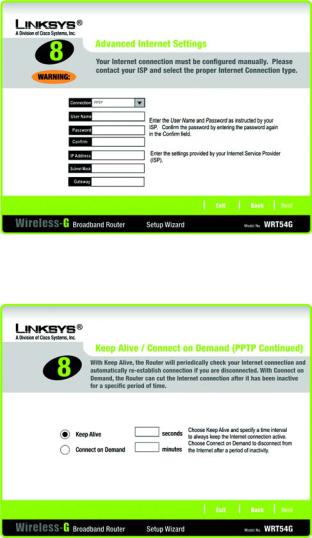
Wireless-G Broadband Router
PPTP
Connection - PPTP (Point-to-Point Tunneling Protocol) service is used in Europe only. If you are using a PPTP connection, select PPTP from the drop-down menu.
User Name - Enter the User Name provided by your ISP.
Password - Enter the Password provided by your ISP.
Confirm - To confirm the Password, enter it again in this field.
IP Address - Enter the IP address provided by your ISP.
Subnet MaskEnter the Subnet Mask provided by your ISP.
Gateway - Enter the Gateway IP address provided by your ISP.
Click the Next button to continue or the Back button to return to the previous screen.
Keep Alive - If you want the Router to periodically check your Internet connection, select Keep Alive. Then specify how often you want the Router to check the Internet connection. If the connection is down, the Router will automatically re-establish your connection.
Connect on Demand - If you want the Router to end the Internet connection after it has been inactive for a period of time, select Connect on Demand and designate the number of minutes you want that period of inactivity to last.
Click the Next button to continue or the Back button to return to the previous screen.
Figure 5-13: Setup Wizard’s Advanced Internet
Settings - PPTP Screen
Figure 5-14: Setup Wizard’s Keep Alive/Connect on Demand (PPTP Continued) Screen
Chapter 5: Setting up the Wireless-G Broadband Router |
18 |
Using the Setup Wizard
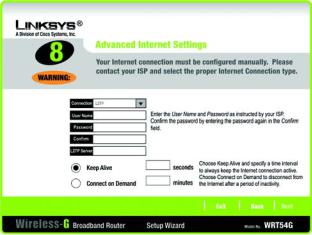
Wireless-G Broadband Router
L2TP
Connection - If you are using an L2TP (Layer 2 Tunneling Protocol) connection, select L2TP from the dropdown menu.
User Name - Enter the User Name provided by your ISP.
Password - Enter the Password provided by your ISP.
Confirm - To confirm the Password, enter it again in this field.
L2TP Server - Enter the IP address of the L2TP server you are using; this should be provided by your ISP.
Keep Alive - If you want the Router to periodically check your Internet connection, select Keep Alive. Then specify how often you want the Router to check the Internet connection. If the connection is down, the Router will automatically re-establish your connection.
Connect on Demand - If you want the Router to end the Internet connection after it has been inactive for a period of time, select Connect on Demand and designate the number of minutes you want that period of inactivity to last.
Click the Next button to continue or the Back button to return to the previous screen.
Chapter 5: Setting up the Wireless-G Broadband Router
Figure 5-15: Setup Wizard’s Advanced Internet Settings -
L2TP Screen
19
Using the Setup Wizard
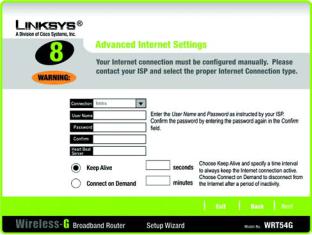
Wireless-G Broadband Router
Telstra
Connection - Telstra is a service used in Australia only. If you are using this service, select Telstra from the drop-down menu.
User Name - Enter the User Name provided by your ISP.
Password - Enter the Password provided by your ISP.
Confirm - To confirm the Password, enter it again in this field.
Heart Beat Server - Enter the IP address of the Heart Beat Server server you are using (this should be provided by your ISP).
Keep Alive - If you want the Router to periodically check your Internet connection, select Keep Alive. Then specify how often you want the Router to check the Internet connection. If the connection is down, the Router will automatically re-establish your connection.
Connect on Demand - If you want the Router to end the Internet connection after it has been inactive for a period of time, select Connect on Demand and designate the number of minutes you want that period of inactivity to last.
Click the Next button to continue or the Back button to return to the previous screen.
Chapter 5: Setting up the Wireless-G Broadband Router
Figure 5-16: Setup Wizard’s Advanced Internet Settings -
Telstra Screen
20
Using the Setup Wizard
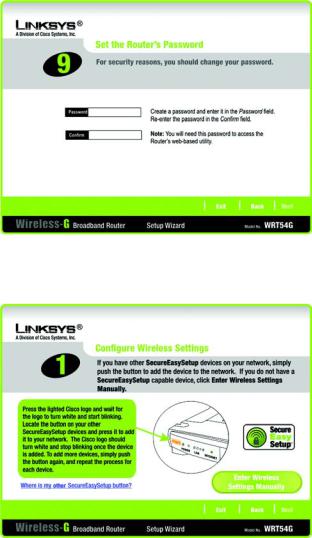
Wireless-G Broadband Router
12.The Router provides a Web-based Utility you can use for configuring the Router from any networked PC.
Password - Enter a password that will control access to the Utility.
Confirm - Enter the password again in the Confirm field.
Click the Next button to continue or the Back button to return to the previous screen.
Figure 5-17: Setup Wizard’s Set the Router’s
Password Screen
13.There are two ways to configure the Router’s wireless settings, SecureEasySetup and manual configuration.
If you have other SecureEasySetup devices, such as notebook adapters or printers, then you can use the Router’s SecureEasySetup feature to create your wireless network. Proceed to the section, “Using the Router’s SecureEasySetup Feature.”
If you do not have other SecureEasySetup devices, then proceed to the section, “Manually Configuring the Router’s Wireless Settings.”
Figure 5-18: Setup Wizard’s Configure Wireless
Settings Screen
Chapter 5: Setting up the Wireless-G Broadband Router |
21 |
Using the Setup Wizard

Wireless-G Broadband Router
Using the Router’s SecureEasySetup Feature
Read these instructions before you press any SecureEasySetup buttons. You should locate the SecureEasySetup buttons of your devices before using the Router’s SecureEasySetup feature.
NOTE: SecureEasySetup uses WPA-Personal encryption. If your current wireless devices do not support WPA-Personal security, then you cannot use SecureEasySetup on your network. You will need to manually configure your network security using the encryption supported by your existing devices.
1.Before you push any button, locate the SecureEasySetup button for each of your other SecureEasySetup devices. If you are not sure where to find this button, click Where is my other SecureEasySetup button?
You will see a screen showing the SecureEasySetup logo. Click the Next button to continue or the Close button to return to the Configure Wireless Settings screen.
You will see a screen with instructions on how to locate the SecureEasySetup hardware button. If your device does not have a hardware button, it most likely will have a software button. Click the Next button for instructions to locate the software button, or click the Close button to return to the Configure Wireless Settings screen.
You will see a screen with instructions on how to locate the SecureEasySetup software button. Click the Close button to return to the Configure Wireless Settings screen.
Chapter 5: Setting up the Wireless-G Broadband Router
Figure 5-19: Setup Wizard’s SecureEasySetup Screen
Figure 5-20: SecureEasySetup Logo
Figure 5-21: Additional Information - Hardware Button
Figure 5-22: Additional Information - Software Button
22
Using the Setup Wizard
